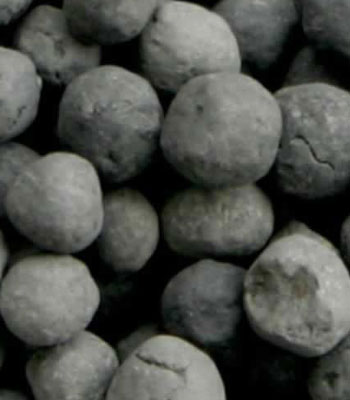Direct Reduced Iron (DRI)
$0.00
Direct Reduced Iron (DRI) is the product of the direct reduction of iron ore in the solid state by carbon monoxide and hydrogen derived from natural gas or coal.
Most gas-based direct reduction plants are part of integrated steel mini-mills, located adjacent to the electric arc furnace (EAF) steel plant. DRI can be either hot or cold charged to the EAF. Some steel companies ship DRI from their captive direct reduction plants to their remote steel mills and a small volume of DRI is sold to third parties. In India there are many small rotary kiln furnaces producing DRI, known locally as sponge iron, using coal as energy and reductant source. Some of the sponge iron plants are captive to steel mills, but there is a significant domestic merchant market, India producing 57% of its crude steel in electric arc furnaces (2016).
| Metallisation | 92.0 – 96.0% |
| Fe (Total) | 86.1 – 93.5% |
| Fe (Metallic) | 81.0 – 87.9% |
| C | 1.0 – 4.5% |
| S | 0.001 – 0.03% |
| P2O5 | 0.005 – 0.09% |
| Gangue* | 3.9 – 8.4% |
| Size (typical) | 4 – 20 mm |
| Apparent Density | 3.4 – 3.6 t/m3 |
| Bulk Density | 1.6 – 1.9 t/m3 |
* residual unreduced oxides, mainly SiO2 and Al2O3,, but also CaO, MgO, MnO, etc.
Benefits in steelmaking
For further information about DRI and its advantages in the EAF, see our Fact Sheet:

 Shipping and handling of DRI
Shipping and handling of DRI
Being a highly reduced material, DRI has a tendency to re-oxidise, an exothermic reaction. Thus, without appropriate precautions being taken in its handling, transport and storage, there is a risk of self-heating and fires. The International Maritime Organisation’s International Maritime Solid Bulk Cargoes Code classifies DRI – Direct Reduced Iron (B) – as Group B (cargo with chemical hazard) and class MHB (material hazardous only in bulk) and requires that DRI be shipped under an inert atmosphere, usually nitrogen.
Further information can be found in IIMA’s Logistics Guide DRI: Guide for Shipping, Handling and Storage (planned 2018).
Direct reduction of iron is the removal of oxygen from iron ore or other iron bearing materials in the solid state, i.e. without melting, as in the blast furnace. The reducing agents are carbon monoxide and hydrogen, coming from reformed natural gas, syngas or coal. Iron ore is used mostly in pellet and/or lumpy form.
The chemical reactions involved in the direct reduction of iron are the following:
With H2
3Fe2O3 + H2 → 2Fe3O4 + H2O
Fe3O4 + H2 → 3 FeO + H2O
FeO + H2 → Fe + H2O
With CO
3Fe2O3 + CO →2Fe3O4 + CO
Fe3O4 + CO → 3 FeO + CO2
FeO + CO → Fe + CO2
With Solid Carbon in reaction
CO2 + C → 2CO
Direct Reduction Processes
There are several processes for direct reduction of iron ore:
- gas-based shaft furnace processes (Midrex® and Energiron being the main ones) – accounting for 75.8% of 2019 DRI production (total 108.1 million tonnes);
- gas-based fluidized bed processes (the Finmet / Finored process being the only commercial scale one in operation) – accounting for 0.2% of 2019 DRI production
- coal based rotary kiln furnaces (mainly in India) – accounting for 24% of 2019 production.
Generic illustrations of the types of process are shown in the graphics below.
Overview of direct reduction process types
Direct reduction furnace types
Direct reduction processes for iron
Illustrations of the principal processes are shown below. The Midrex® and Energiron gas-based processes use predominantly iron ore pellets as feedstock, but sometimes with inclusion of lump ore in the furnace charge. The Finmet / Finored gas-based process utilizes iron ore fines as feedstock. The SLRN coal-based rotary kiln process uses lump ore and, increasingly, pellets as feedstock. There are variants of these processes which are described on the websites of the various technology providers.
Midrex® process
Energiron process
Standard Energiron process flowsheet
Finmet / Finored Megatrain process
SLRN process
SLRN direct reduction process flowsheet


MAECENAS IACULIS
Vestibulum curae torquent diam diam commodo parturient penatibus nunc dui adipiscing convallis bulum parturient suspendisse parturient a.Parturient in parturient scelerisque nibh lectus quam a natoque adipiscing a vestibulum hendrerit et pharetra fames nunc natoque dui.
ADIPISCING CONVALLIS BULUM
- Vestibulum penatibus nunc dui adipiscing convallis bulum parturient suspendisse.
- Abitur parturient praesent lectus quam a natoque adipiscing a vestibulum hendre.
- Diam parturient dictumst parturient scelerisque nibh lectus.
Scelerisque adipiscing bibendum sem vestibulum et in a a a purus lectus faucibus lobortis tincidunt purus lectus nisl class eros.Condimentum a et ullamcorper dictumst mus et tristique elementum nam inceptos hac parturient scelerisque vestibulum amet elit ut volutpat.
General Inquiries
There are no inquiries yet.







 Shipping and handling of DRI
Shipping and handling of DRI






Reviews
There are no reviews yet.